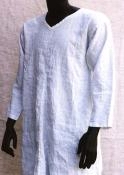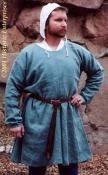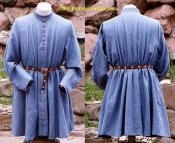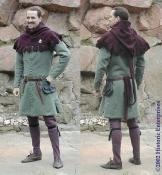Braes

Photo courtesy of Historic Enterprises ©2004
There is little in the way of hard data on this most basic of garments. Most information comes from illustrations, leaving actual construction open to speculation. Simple, boxer style braies as seen in the Four Seasons of the House of Cerruti (“Barley”), Tacuinum Sanitatis (“Rye”) and other manuscripts of the 14th century. Made of opaque linen.
Braes should be made of linen, almost always white (or natural fabric color). They appear to have been held up by drawstrings (cording or linen tape) or by a belt called a brygyrdyl (a brae-girdle). You can select either method.
Braes may be worn with chausses for 14th and early 15th century styles. They must, of course, have minimal visible exterior machine stitching.
Chausses

Photo courtesy of Historic Enterprises ©2004
Single leg hose can be seen in artwork from the 13th (Maciejowski Bible), 14th (Tres Riches Heures) and early 15th (Mantegna) centuries. Worn laced to braes or belt, these versatile leggings may be worn rolled down to knee in hot weather.
Shirt

Photo courtesy of Historic Enterprises ©2004
Based on the shirt of St. Louis (King Louis IX of France), which is preserved in Notre Dame, Paris. The original dates to 1250, and is said to be the oldest extant undergarment. This example shirt copies the cut of the original, and is made of fine white linen. Appropriate for wear under tunics and cotehardies. Pair with braes and chausses. Should have no visible exterior machine stitching. Shirts should always be white (or natural fabric color).
Tunic or cote



Photos courtesy of Historic Enterprises ©2004
The tunic design suggested for a simple commoner is based the tunic documented in Bockstensmannen by Margareta Nockert. The tunic is of similar form to the shirt but is fuller in the skirt.
The tunic is typically wool, however it might be made of linen for summer wear. Tunics might be dyed in any number of natural dye colors although red and blue were popular.
or Cotehardie

Photo courtesy of Historic Enterprises ©2004
A shapely jacket popular during the mid 14th century, this garment is copied from the tomb effigy of Walter Helyon, franklin of Marcle, c. 1355-60 (Church of St Bartholomew, Herefordshire). It features the nipped in waist and variously spaced buttons seen on the effigy. Buttoned length of front and wrist, vents at side bottom.
Hood material is wool again in all the usual veggie dye colors.
Footwear

Footwear
Simple turnshoes, or riding boots.
Hood

Photo courtesy of Historic Enterprises ©2004
The most common form of headgear is a hood. Hoods are made of wool or linen and may be lined or unlined. Coifs are most commonly made of white linen. However, the coif is an arming garment and was not worn by persons of any but the lowest classes, or by those holding official positions.